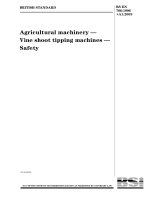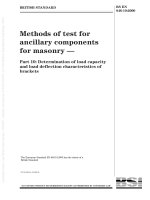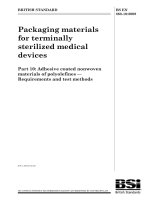Bsi bs en 61290 10 1 2009
Bạn đang xem bản rút gọn của tài liệu. Xem và tải ngay bản đầy đủ của tài liệu tại đây (1.02 MB, 32 trang )
BS EN 61290-10-1:2009
BSI British Standards
Optical amplifiers — Test
methods —
Part 10-1: Multichannel parameters — Pulse
method using an optical switch and optical
spectrum analyzer
NO COPYING WITHOUT BSI PERMISSION EXCEPT AS PERMITTED BY COPYRIGHT LAW
raising standards worldwide™
Copyright European Committee for Electrotechnical Standardization
Provided by IHS under license with CENELEC
No reproduction or networking permitted without license from IHS
--`,,```,,,,````-`-`,,`,,`,`,,`---
Not for Resale
BRITISH STANDARD
BS EN 61290-10-1:2009
National foreword
This British Standard is the UK implementation of EN 61290-10-1:2009. It is
identical to IEC 61290-10-1:2009. It supersedes BS EN 61290-10-1:2003
which is withdrawn.
The UK participation in its preparation was entrusted by Technical Committee
GEL/86, Fibre optics, to Subcommittee GEL/86/3, Fibre optic systems and
active devices.
A list of organizations represented on this committee can be obtained on
request to its secretary.
This publication does not purport to include all the necessary provisions of a
contract. Users are responsible for its correct application.
© BSI 2009
ISBN 978 0 580 60094 4
ICS 33.180.30
Compliance with a British Standard cannot confer immunity from
legal obligations.
This British Standard was published under the authority of the Standards
Policy and Strategy Committee on 31 July 2009
Amendments issued since publication
Amd. No.
Date
--`,,```,,,,````-`-`,,`,,`,`,,`---
Copyright European Committee for Electrotechnical Standardization
Provided by IHS under license with CENELEC
No reproduction or networking permitted without license from IHS
Not for Resale
Text affected
EUROPEAN STANDARD
EN 61290-10-1
NORME EUROPÉENNE
May 2009
EUROPÄISCHE NORM
ICS 33.180.30
Supersedes EN 61290-10-1:2003
English version
--`,,```,,,,````-`-`,,`,,`,`,,`---
Optical amplifiers Test methods Part 10-1: Multichannel parameters Pulse method using an optical switch
and optical spectrum analyzer
(IEC 61290-10-1:2009)
Prüfverfahren
für Lichtwellenleiter-Verstärker Teil 10-1: Mehrkanalparameter Pulsmethode bei Verwendung
eines optischen Schalters
und optischen Spektralanalysators
(IEC 61290-10-1:2009)
Amplificateurs optiques Méthodes d'essai Partie 10-1: Paramètres
à canaux multiples Méthode d’impulsion utilisant
un interrupteur optique
et un analyseur de spectre optique
(CEI 61290-10-1:2009)
This European Standard was approved by CENELEC on 2009-04-01. CENELEC members are bound to comply
with the CEN/CENELEC Internal Regulations which stipulate the conditions for giving this European Standard
the status of a national standard without any alteration.
Up-to-date lists and bibliographical references concerning such national standards may be obtained on
application to the Central Secretariat or to any CENELEC member.
This European Standard exists in three official versions (English, French, German). A version in any other
language made by translation under the responsibility of a CENELEC member into its own language and notified
to the Central Secretariat has the same status as the official versions.
CENELEC members are the national electrotechnical committees of Austria, Belgium, Bulgaria, Cyprus, the
Czech Republic, Denmark, Estonia, Finland, France, Germany, Greece, Hungary, Iceland, Ireland, Italy, Latvia,
Lithuania, Luxembourg, Malta, the Netherlands, Norway, Poland, Portugal, Romania, Slovakia, Slovenia, Spain,
Sweden, Switzerland and the United Kingdom.
CENELEC
European Committee for Electrotechnical Standardization
Comité Européen de Normalisation Electrotechnique
Europäisches Komitee für Elektrotechnische Normung
Central Secretariat: Avenue Marnix 17, B - 1000 Brussels
© 2009 CENELEC -
All rights of exploitation in any form and by any means reserved worldwide for CENELEC members.
Ref. No. EN 61290-10-1:2009 E
Copyright European Committee for Electrotechnical Standardization
Provided by IHS under license with CENELEC
No reproduction or networking permitted without license from IHS
Not for Resale
BS EN 61290-10-1:2009
EN 61290-10-1:2009
–2–
Foreword
The text of document 86C/778/CDV, future edition 2 of IEC 61290-10-1, prepared by SC 86C, Fibre optic
systems and active devices, of IEC TC 86, Fibre optics, was submitted to the IEC-CENELEC parallel vote
and was approved by CENELEC as EN 61290-10-1 on 2009-04-01.
This European Standard supersedes EN 61290-10-1:2003.
It contains updated references and cautions on proper use of the procedure.
The following dates were fixed:
– latest date by which the EN has to be implemented
at national level by publication of an identical
national standard or by endorsement
(dop)
2010-01-01
– latest date by which the national standards conflicting
with the EN have to be withdrawn
(dow)
2012-04-01
Annex ZA has been added by CENELEC.
__________
Endorsement notice
The text of the International Standard IEC 61290-10-1:2009 was approved by CENELEC as a European
Standard without any modification.
In the official version, for Bibliography, the following notes have to be added for the standards indicated:
IEC 60793-1
NOTE Harmonized in EN 60793-1 series (partially modified).
IEC 60825-1
NOTE Harmonized as EN 60825-1:2007 (not modified).
IEC 60825-2
NOTE Harmonized as EN 60825-2:2004 (not modified).
IEC 60874-1
NOTE Harmonized as EN 60874-1:2007 (not modified).
IEC 61290-1-1
NOTE Harmonized as EN 61290-1-1:2006 (not modified).
IEC 61290-3
NOTE Harmonized as EN 61290-3:2008 (not modified).
__________
Copyright European Committee for Electrotechnical Standardization
Provided by IHS under license with CENELEC
No reproduction or networking permitted without license from IHS
Not for Resale
--`,,```,,,,````-`-`,,`,,`,`,,`---
This European Standard is to be read in conjunction with EN 61291-1.
BS EN 61290-10-1:2009
–3–
EN 61290-10-1:2009
Annex ZA
(normative)
Normative references to international publications
with their corresponding European publications
The following referenced documents are indispensable for the application of this document. For dated
references, only the edition cited applies. For undated references, the latest edition of the referenced
document (including any amendments) applies.
NOTE When an international publication has been modified by common modifications, indicated by (mod), the relevant EN/HD
applies.
Publication
IEC 61291-1
1)
2)
Year
-
1)
Title
EN/HD
Year
Optical amplifiers Part 1: Generic specification
EN 61291-1
2006
Undated reference.
Valid edition at date of issue.
--`,,```,,,,````-`-`,,`,,`,`,,`---
Copyright European Committee for Electrotechnical Standardization
Provided by IHS under license with CENELEC
No reproduction or networking permitted without license from IHS
Not for Resale
2)
IEC 61290-10-1
®
Edition 2.0
2009-03
INTERNATIONAL
STANDARD
NORME
INTERNATIONALE
Optical amplifiers – Test methods –
Part 10-1: Multichannel parameters – Pulse method using an optical switch and
optical spectrum analyzer
Amplificateurs optiques – Méthodes d'essai
Partie 10-1: Paramètres à canaux multiples – Méthode d’impulsion utilisant un
interrupteur optique et un analyseur de spectre optique
INTERNATIONAL
ELECTROTECHNICAL
COMMISSION
COMMISSION
ELECTROTECHNIQUE
INTERNATIONALE
PRICE CODE
CODE PRIX
ISBN 2-8318-1032-3
ICS 33.180.30
--`,,```,,,,````-`-`,,`,,`,`,,`---
® Registered trademark of the International Electrotechnical Commission
Copyright European Committee Marque
for Electrotechnical
déposéeStandardization
de la Commission Electrotechnique Internationale
Provided by IHS under license with CENELEC
No reproduction or networking permitted without license from IHS
T
Not for Resale
–2–
BS EN 61290-10-1:2009
61290-10-1 © IEC:2009
CONTENTS
FOREWORD...........................................................................................................................4
INTRODUCTION.....................................................................................................................6
1
Scope and object..............................................................................................................7
2
Normative references .......................................................................................................7
3
Abbreviated terms ............................................................................................................7
4
Apparatus .........................................................................................................................8
5
Test sample.................................................................................................................... 10
6
Procedure ...................................................................................................................... 10
7
Calibration............................................................................................................. 11
6.1.1 Calibration of OSA power measurement .................................................... 11
6.1.2 Calibration of the pulse duty ratio .............................................................. 11
6.1.3 Calibration of the sampling module ............................................................ 12
6.1.4 Calibration of dynamic isolation ................................................................. 13
6.2 OA measurement .................................................................................................. 15
6.2.1 Timing adjustment for ASE and amplified signal power measurement ........ 15
6.2.2 ASE measurement ..................................................................................... 16
6.2.3 Amplified signal power measurement......................................................... 16
Calculation ..................................................................................................................... 17
8
7.1
7.2
7.3
7.4
7.5
7.6
Test
General ................................................................................................................. 17
Noise factor calculation ......................................................................................... 18
ASE power ............................................................................................................ 18
Gain calculation .................................................................................................... 19
Average output signal power ................................................................................. 19
Noise figure calculation ......................................................................................... 19
results .................................................................................................................... 19
Annex A (informative) Output waveforms for various EDFAs at 25 kHz and 500 kHz
pulse rates ............................................................................................................................ 20
Annex B (informative)
Measurement accuracy versus pulse rate......................................... 22
Annex C (informative)
Pulse repetition frequency measurements ........................................ 23
Bibliography.......................................................................................................................... 24
Figure 1 – Typical arrangement of the optical pulse test method .............................................8
Figure 2 – Two arrangements of the optical pulse source........................................................9
Figure 3 – Static isolation of an optical switch.........................................................................9
Figure 4 – Definitions of rise time and fall time, t r and t f of optical pulses ............................. 10
Figure 5 – Measurement flow chart ....................................................................................... 11
Figure 6 – Arrangement for the sampling switch calibration................................................... 12
Figure 7 – Arrangement for timing adjustment....................................................................... 13
Figure 8 – Timing adjustment of the sampling switch ............................................................ 14
Figure 9 – Timing chart for dynamic isolation calibration ....................................................... 15
Figure 10 – Arrangement for OA measurement ..................................................................... 16
Figure 11 – Timing chart for ASE measurement .................................................................... 17
Figure 12 – Timing chart for amplified signal power measurement ........................................ 17
Copyright European Committee for Electrotechnical Standardization
Provided by IHS under license with CENELEC
No reproduction or networking permitted without license from IHS
Not for Resale
--`,,```,,,,````-`-`,,`,,`,`,,`---
6.1
BS EN 61290-10-1:2009
61290-10-1 © IEC:2009
–3–
Figure A.1 – EDFA output waveforms for various EDFAs ...................................................... 21
Figure B.1 – NF measurement accuracy versus pulse rate .................................................... 22
Figure C.1 – Set-up to evaluate gain recovery error versus modulation rate.......................... 23
Figure C.2 – Gain recovery error versus modulation frequency with pump current as a
parameter ............................................................................................................................. 23
--`,,```,,,,````-`-`,,`,,`,`,,`---
Copyright European Committee for Electrotechnical Standardization
Provided by IHS under license with CENELEC
No reproduction or networking permitted without license from IHS
Not for Resale
BS EN 61290-10-1:2009
61290-10-1 © IEC:2009
–4–
INTERNATIONAL ELECTROTECHNICAL COMMISSION
____________
OPTICAL AMPLIFIERS –
TEST METHODS –
Part 10-1: Multichannel parameters –
Pulse method using an optical switch
and optical spectrum analyzer
FOREWORD
1) The International Electrotechnical Commission (IEC) is a worldwide organization for standardization comprising
all national electrotechnical committees (IEC National Committees). The object of IEC is to promote international
co-operation on all questions concerning standardization in the electrical and electronic fields. To this end and in
addition to other activities, IEC publishes International Standards, Technical Specifications, Technical Reports,
Publicly Available Specifications (PAS) and Guides (hereafter referred to as “IEC Publication(s)”). Their
preparation is entrusted to technical committees; any IEC National Committee interested in the subject dealt with
may participate in this preparatory work. International, governmental and non-governmental organizations liaising
with the IEC also participate in this preparation. IEC collaborates closely with the International Organization for
Standardization (ISO) in accordance with conditions determined by agreement between the two organizations.
2) The formal decisions or agreements of IEC on technical matters express, as nearly as possible, an international
consensus of opinion on the relevant subjects since each technical committee has representation from all
interested IEC National Committees.
3) IEC Publications have the form of recommendations for international use and are accepted by IEC National
Committees in that sense. While all reasonable efforts are made to ensure that the technical content of IEC
Publications is accurate, IEC cannot be held responsible for the way in which they are used or for any
misinterpretation by any end user.
4) In order to promote international uniformity, IEC National Committees undertake to apply IEC Publications
transparently to the maximum extent possible in their national and regional publications. Any divergence between
any IEC Publication and the corresponding national or regional publication shall be clearly indicated in the latter.
5) IEC provides no marking procedure to indicate its approval and cannot be rendered responsible for any equipment
declared to be in conformity with an IEC Publication.
6) All users should ensure that they have the latest edition of this publication.
7) No liability shall attach to IEC or its directors, employees, servants or agents including individual experts and
members of its technical committees and IEC National Committees for any personal injury, property damage or
other damage of any nature whatsoever, whether direct or indirect, or for costs (including legal fees) and expenses
arising out of the publication, use of, or reliance upon, this IEC Publication or any other IEC Publications.
8) Attention is drawn to the Normative references cited in this publication. Use of the referenced publications is
indispensable for the correct application of this publication.
9) Attention is drawn to the possibility that some of the elements of this IEC Publication may be the subject of patent
rights. IEC shall not be held responsible for identifying any or all such patent rights
International Standard IEC 61290-10-1 has been prepared by subcommittee 86C: Fibre optic
systems and active devices, of IEC technical committee 86: Fibre optics.
This second edition cancels and replaces the first edition published in 2003. It is a technical
revision with updated references and cautions on proper use of the procedure.
This International Standard is to be read in conjunction with IEC 61291-1.
The text of this standard is based on the following documents:
CDV
Report on voting
86C/778/CDV
86C/809/RVC
Full information on the voting for the approval of this standard can be found in the report on
voting indicated in the above table.
--`,,```,,,,````-`-`,,`,,`,`,,`---
Copyright European Committee for Electrotechnical Standardization
Provided by IHS under license with CENELEC
No reproduction or networking permitted without license from IHS
Not for Resale
BS EN 61290-10-1:2009
61290-10-1 © IEC:2009
–5–
This publication has been drafted in accordance with the ISO/IEC Directives, Part 2.
The committee has decided that the contents of this publication will remain unchanged until the
maintenance result date indicated on the IEC web site under "" in the data
related to the specific publication. At this date, the publication will be
•
•
•
•
reconfirmed,
withdrawn,
replaced by a revised edition, or
amended.
___________
1) The first editions of some of these parts were published under the general title Optical fibre amplifiers – Basic
specification or Optical amplifier test methods.
Copyright European Committee for Electrotechnical Standardization
Provided by IHS under license with CENELEC
No reproduction or networking permitted without license from IHS
Not for Resale
--`,,```,,,,````-`-`,,`,,`,`,,`---
A list of all parts of the IEC 61290 series, published under the general title Optical amplifiers –
Test methods 1) can be found on the IEC website.
–6–
BS EN 61290-10-1:2009
61290-10-1 © IEC:2009
INTRODUCTION
This International Standard is devoted to the subject of optical fibre amplifiers. The technology
of optical fibre amplifiers is still rapidly evolving, hence amendments and new editions to this
standard can be expected.
--`,,```,,,,````-`-`,,`,,`,`,,`---
Copyright European Committee for Electrotechnical Standardization
Provided by IHS under license with CENELEC
No reproduction or networking permitted without license from IHS
Not for Resale
BS EN 61290-10-1:2009
61290-10-1 © IEC:2009
–7–
OPTICAL AMPLIFIERS –
TEST METHODS –
Part 10-1: Multichannel parameters –
Pulse method using an optical switch
and optical spectrum analyzer
1
Scope and object
This part of IEC 61290 applies to optical amplifiers (OAs) using active fibres and waveguides,
containing rare-earth dopants, currently commercially available.
The object of this standard is to establish uniform requirements for accurate and reliable
measurements of the signal-spontaneous noise figure as defined in IEC 61291-1.
--`,,```,,,,````-`-`,,`,,`,`,,`---
The test method independently detects amplified signal power and amplified spontaneous
emission (ASE) power by launching optical pulses into the OA under test and synchronously
detecting "on" and "off" levels of the output pulses by using an optical sampling switch and an
optical spectrum analyzer (OSA).
Such measurement is possible because the gain response of the rare-earth doped OA is
relatively slow, particularly in Er-doped OAs. However, since the OA gain dynamics vary
with amplifier types, operating conditions and control schemes, the gain dynamics should be
carefully considered when applying the present test method to various OA. The manufacturer of
the OA should present data validating the required modulation frequency to limit the error to
<1 dB. The measurements for obtaining this information are described in Annex C.
The test method is described basically for multichannel applications, which includes single
channel applications as a special case of multichannel (wavelength-division multiplexed)
applications.
NOTE
2
All numerical values followed by (‡) are currently under study.
Normative references
The following referenced documents are indispensable for the application of this document. For
dated references, only the edition cited applies. For undated references, the latest edition of the
referenced document (including any amendments) applies.
IEC 61291-1, Optical amplifiers – Part 1: Generic specification
3
Abbreviated terms
For the purposes of this document, the following abbreviated terms apply:
AGC
automatic gain control
ALC
automatic level control
AOM
acousto-optic modulator
APC
automatic power control
ASE
amplified spontaneous emission
CW
continuous wave
Copyright European Committee for Electrotechnical Standardization
Provided by IHS under license with CENELEC
No reproduction or networking permitted without license from IHS
Not for Resale
BS EN 61290-10-1:2009
61290-10-1 © IEC:2009
–8–
4
DBR
distributed Bragg reflector (laser diode)
DC
direct current
DFB
distributed feed-back (laser diode)
ECL
external cavity laser (diode)
EDFA
erbium-doped fibre amplifier
ER
erbium
FWHM
full width at half maximum
LED
light emitting diode
LD
laser diode
NF
noise figure
OA
optical amplifier
OSA
optical spectrum analyzer
SW
switch
Apparatus
The basic measurement set-up is given in Figure 1.
Optical pulse
source
Optical pulses
typical repetition rate
500 kHz to 1 000 kHz
OA under test
OA
SW
Optical spectrum
analyzer
Trigger
IEC 310/09
Figure 1 – Typical arrangement of the optical pulse test method
The test equipment needed, with the required characteristics, is listed below.
a) Optical pulse source: Two arrangements of the optical pulse source are possible as shown in
Figure 2. Optical pulse source a (Figure 2a) consists of CW optical sources with an external
optical switch and attenuator(s). Optical pulse source b (Figure 2b) consists of directly
modulated optical sources and attenuator(s).
Optical pulse source
Optical attenuator(s)
Optical sources
operating at CW
dB
Optical switch
IEC 311/09
--`,,```,,,,````-`-`,,`,,`,`,,`---
Figure 2a – Arrangement with external optical switch
Copyright European Committee for Electrotechnical Standardization
Provided by IHS under license with CENELEC
No reproduction or networking permitted without license from IHS
Not for Resale
BS EN 61290-10-1:2009
61290-10-1 © IEC:2009
–9–
Optical pulse source
Optical attenuator(s)
Optical sources
pulsated by direct
modulation
dB
IEC 312/09
Figure 2b – Arrangement with directly modulated optical source
Figure 2 – Two arrangements of the optical pulse source
Unless otherwise specified, the full width at half maximum (FWHM) of the output spectrum of
optical pulse source a or b shall be narrower than 0,1 nm (‡) so as not to cause any
interference to adjacent channels. In the case of a single-channel source, it shall be
narrower than 1 nm (‡). Distributed feedback (DFB) lasers, distributed Bragg reflection (DBR)
lasers, and external cavity lasers (ECLs), for example, are applicable. The suppression ratio
of the side modes of these DFB lasers shall be higher than 30 dB (‡). The output power
fluctuation shall be less than 0,05 dB (‡), which may be more easily attainable with an optical
isolator placed at the output port of each source.
Optical pulse source a simultaneously pulsates wavelength-division multiplexed light with an
optical switch, where the switching time is common to all the channels; timing adjustment is
not needed. Moreover, frequency chirping and spontaneous emission can be minimum; the
extinction ratio of the "on" versus "off" stages can be uniquely determined at a high level if a
high extinction-ratio switch is used. An acousto-optic modulator (AOM) is typically used as
the switch.
For optical pulse source b, the leakage power at the off-state should be as small as possible
to minimize the measurement error, although calibration is possible by subtracting the
leaked power. This may demand a zero-bias operation of laser diode sources. Moreover,
care must be taken in synchronizing optical pulses because the pulse timing may differ from
one source to another.
b) Variable optical attenuator: The attenuation range and stability shall be over 40 dB (‡) and
better than ± 0,1 dB (‡), respectively. The reflectance from this device shall be smaller than
−40 dB (‡) at each port. The variable optical attenuator may be incorporated in the optical
pulse source.
c) Optical switch: This device shall have a polarization sensitivity less than ± 0,1 dB (‡), static
isolation better than 65 dB (‡), transition time less than 50 ns (‡), and switching delay time
less than 2 ms (‡). The reflectance from this device shall be smaller than –40 dB (‡) at each
port. Figure 3 defines the optical switch static isolation. The optical switch is not required for
optical pulse source b.
Switching signal
Output
pulse
Light
source
SW
Power
meter
IEC 313/09
ISO static =
Poff - state
Pon - state
Figure 3 – Static isolation of an optical switch
--`,,```,,,,````-`-`,,`,,`,`,,`---
d) Pulse generator: This device is used to drive optical pulse sources and the optical sampling
switch. When using an internally modulated optical pulse source, an independent pulse
generator is not required. Pulse train(s) shall be generated with a pulse interval of, typically,
1 μs to 2 μs (‡). The pulse widths shall be adjustable from 100 ns to 2 ms (‡) with a step of
5 ns or finer. The delay shall be adjustable at least from 100 ns to 4 μs (‡) in steps of 5 ns or
Copyright European Committee for Electrotechnical Standardization
Provided by IHS under license with CENELEC
No reproduction or networking permitted without license from IHS
Not for Resale
BS EN 61290-10-1:2009
61290-10-1 © IEC:2009
– 10 –
finer. The rise time and fall time, t r and t f , of the output optical pulse shall be less than 10 ns
(‡). Definitions of t r and t f are given in Figure 4.
1
SW
output
pulse
10 %
to
90 %
0
tr
tf
Time
IEC 314/09
Figure 4 – Definitions of rise time and fall time, t r and t f of optical pulses
e) Optical spectrum analyzer: This device shall have polarization sensitivity less than
0,1 dB (‡), stability better than ±0,1 dB (‡),wavelength accuracy better than ±0,5 nm (‡), and
wavelength reproducibility better than 0,01 nm (‡). The device shall have a measurement
range at least from –75 dBm to +20 dBm (‡) with a resolution better than 0,1 nm (‡). The
reflectance from this device shall be smaller than –40 dB (‡) at its input port.
f)
Optical power meter: This device shall have a measurement accuracy better than ±0,2 dB
(‡), irrespective of the state of the input light polarization, within the operational wavelength
band of the OA and within a power range from –40 dBm to +20 dBm (‡).
g) Optical connectors: The connection loss repeatability shall be better than ±0,1 dB (‡). The
reflectance from this device shall be smaller than –40 dB (‡).
h) Optical fibre jumpers: The mode field diameter of the optical fibre jumpers shall be as close
as possible, so as not to cause excessive loss and reflectance, to that of fibres used as input
and output ports of the OA. The reflectance from optical fibre jumpers shall be smaller than
–40 dB (‡), and the device length shall be short (<2 m).
5
Test sample
The OA shall operate at nominal operating conditions. If the OA is likely to cause laser
oscillations due to unwanted reflections, optical isolators should be used to bracket the OA
under test. This will minimize the signal instability and the measurement inaccuracy.
--`,,```,,,,````-`-`,,`,,`,`,,`---
Care shall be taken in the state of polarization of the input light during the measurement.
Changes in the polarization state of the input light may result in input optical power changes
because of the slight polarization dependency expected from all the optical components used,
leading to measurement errors.
6
Procedure
The test procedure consists of four parts:
a) initial system setting and calibration;
b) sampling window adjustment;
c) OA measurement and
d) calculation.
Copyright European Committee for Electrotechnical Standardization
Provided by IHS under license with CENELEC
No reproduction or networking permitted without license from IHS
Not for Resale
BS EN 61290-10-1:2009
61290-10-1 © IEC:2009
– 11 –
The measurement flow is given in Figure 5. This procedure enables self-consistent calculation of
not only OA noise factor but also ASE power and signal gain.
Start
Initial system setting
λ1 to λN
Initial calibration
OA setting
Sampling window
adjustment for OA
OA parameter setting
λ1 to λN
Measurement
Calculation
and printout
Parameter change
IEC 315/09
Figure 5 – Measurement flow chart
6.1
6.1.1
Calibration
Calibration of OSA power measurement
Calibrate the OSA power measurement by using a calibrated power meter.
--`,,```,,,,````-`-`,,`,,`,`,,`---
NOTE The calibrated optical power meter detects all the optical power including source spontaneous emission,
whereas the OSA measurement detects just the optical power within the resolution bandwidth of the OSA. Therefore,
use of an optical filter with a FWHM passband of 1 nm to 3 nm is recommended at the output of the optical pulse source
to increase the calibration accuracy.
6.1.2
Calibration of the pulse duty ratio
Follow the steps below to calibrate the pulse duty ratio.
a) Activate any one channel of the optical pulse source at CW and the specified power and
wavelength.
b) Set the pulse width T source and the pulse interval T of the optical pulse source output as
specified in the product specification. T source and T shall be sufficiently shorter than the
gain-response time of the OA under test. For EDFAs, T source and T are typically 0,4 μs (‡)
Copyright European Committee for Electrotechnical Standardization
Provided by IHS under license with CENELEC
No reproduction or networking permitted without license from IHS
Not for Resale
BS EN 61290-10-1:2009
61290-10-1 © IEC:2009
– 12 –
and 1 μs (‡), respectively. These values, however, depend on the amplifier saturation
condition.
NOTE Measurement accuracy versus pulse rates is given in informative Annex B. EDFA output waveforms for
various EDFAs are given in informative Annex A.
c) Measure the average output power, P pulse-ave , with a power meter.
d) Drive the optical pulse source with 100 % duty pulse (DC drive), and measure the output
power, P DC , with a power meter.
e) Calculate the equivalent duty ratio by using Equation (1).
DR source =
Ppulse - ave
(1)
PDC
NOTE For the optical pulse source using an external optical switch, the calibration result is applicable to the
other channels.
For the optical pulse source using direct modulation, the calibration shall be repeated for all the
channels, because the optical-pulse shape generated by each source can be different.
6.1.3
Calibration of the sampling module
Follow the steps below to calibrate the sampling module.
a) Arrange the optical pulse source, sampling SW, OSA and calibrated power meter as shown
in Figure 6.
Sampling pulse
CW light
source
PCW-calibrated
Tsampler
T
OSA
SW
Calibrated
power meter
IEC 316/09
Figure 6 – Arrangement for the sampling switch calibration
b) Activate the optical pulse source to emit CW light at a channel wavelength to be tested.
c) Set the OSA optical bandwidth, B o , in a way to accommodate the spectral bandwidth of the
pulse signal.
d) Adjust the OSA centre wavelength to the wavelength selected at step b).
e) Set the sampling pulse width, T sampler , as specified in the product specification. The sum of
the duty ratios, the source duty ratio plus sampler duty ratio, shall be less than 100 % while
still keeping some margin, e.g., 80 % to 90 %. T sampler shall be smaller than T source . Measure
the average output power, P OSA-pulse-ave with the OSA.
f)
Drive the sampling switch with a 100 % duty pulse (DC drive).
g) Measure P OSA-DC with the OSA.
DR sampler =
Copyright European Committee for Electrotechnical Standardization
Provided by IHS under license with CENELEC
No reproduction or networking permitted without license from IHS
POSA − pulse − ave
POSA -DC
Not for Resale
(2)
--`,,```,,,,````-`-`,,`,,`,`,,`---
h) Calculate the equivalent sampling switch duty ratio by using Equation (2).
BS EN 61290-10-1:2009
61290-10-1 © IEC:2009
– 13 –
NOTE The value of DR sampler thus obtained at one channel wavelength is applicable to the other channel
wavelengths.
i)
Measure the input power to the sampling switch, P CW-calibd , with a calibrated power meter.
j) Activate the optical pulse source to emit CW light at the next channel wavelength to be tested.
Repeat steps g) through i) for the next channel wavelength to be measured.
k) Calculate the calibration factor, CAL ( λ k ), of the sampler including the OSA by using
Equation (3).
CAL ( λ k )=
6.1.4
POSA −DC
PCW − calibd
(3)
Calibration of dynamic isolation
6.1.4.1
Timing adjustment of the sampling switch (SW)
Follow the steps below for timing adjustment of the sampling switch.
a) Connect the optical pulse source and the sampling switch plus OSA with a fibre cord as
shown in Figure 7, in which optical pulse source a is illustrated as the optical pulse source.
Optical pulse source b is also applicable here.
Optical pulse source
Narrow band
optical source
dB
Fibre cord
Sampling SW
SW
OSA
CH-1
Pulse
generator
CH-2
Td
IEC 317/09
Figure 7 – Arrangement for timing adjustment
b) Activate the optical pulse source to emit light at all channel wavelengths.
NOTE Although the delay time can be determined by using just one channel, the present test procedure
activates all the channels at this stage so that the multichannel optical pulse source can be better stabilized for
later stages of the measuring procedure.
c) Adjust the OSA centre wavelength to one arbitrary channel wavelength.
d) Set the drive pulse timing for the optical pulse source and the sampling switch as shown in
Figure 8. DR sampler shall be smaller than DR source .
e) Find the delay time, T d-min , that minimizes the received optical power with the OSA by tuning
the CH2 delay time T d .
f)
Calculate the delay time T d-max that maximizes the received optical power with the OSA by
using Equation (4).
T d-max = T d-min –
NOTE
Tp
2
(4)
The delay time thus obtained at one channel wavelength is applicable to the other channel wavelengths.
--`,,```,,,,````-`-`,,`,,`
Copyright European Committee for Electrotechnical Standardization
Provided by IHS under license with CENELEC
No reproduction or networking permitted without license from IHS
Not for Resale
BS EN 61290-10-1:2009
61290-10-1 © IEC:2009
– 14 –
Source output
Source module
SW output
Fibre cord
input pulses
Fibre cord
output pulses
Fibre cord delay
Sampling
SW output
Td
OSA input
Time
--`,,```,,,,````-`-`,,`,,`,`,,`---
Leakage signal
from source module
Leakage signal
from sampler
IEC 318/09
Figure 8 – Timing adjustment of the sampling switch
6.1.4.2
Dynamic isolation
Follow the steps below to calculate the dynamic isolation.
a) Keep activating the optical pulse source to emit light pulses at all channel wavelengths.
NOTE All the channels need to be active when measuring the dynamic isolation. This is because, although the
dynamic isolation is measured by tuning the OSA to one channel, the OSA should receive all the optical powers
including those from adjacent channels.
b) Connect the optical pulse source and the sampling switch plus OSA with a fibre cord as
shown in Figure 7.
c) Set the sampling switch timing as shown in Figure 9a. Measure P Sig OSA-ave with the OSA
tuned to the channel to be tested.
d) Set the sampling switch timing as shown in Figure 9b. Measure P Leak OSA-ave with the OSA
tuned to the same channel as in step c).
e) Repeat steps c) and d) for the different channels to be tested.
f)
Calculate the average dynamic isolation of each channel, ISO ( λ k ) dyna-ave , by using
Equation (5).
ISO ( λ k ) dyna-ave =
Copyright European Committee for Electrotechnical Standardization
Provided by IHS under license with CENELEC
No reproduction or networking permitted without license from IHS
P Leak OSA −ave
P SigOSA −ave
Not for Resale
(5)
BS EN 61290-10-1:2009
61290-10-1 © IEC:2009
– 15 –
Fibre cord
output
Sampling
Sw output
Td_min
Td_max
OSA input
Time
Leakage signal
from source module
Leakage signal
from sampler
IEC 319/09
IEC 320/09
Figure 9a – Measurements of P OSA-ave Sig
Figure 9b – Measurements of P OSA-ave Leak
Figure 9 – Timing chart for dynamic isolation calibration
6.2
OA measurement
6.2.1
Timing adjustment for ASE and amplified signal power measurement
Follow the steps below to adjust the timing for ASE and amplified signal power measurement.
a) Keep activating the optical pulse source to emit pulsed light at all channel wavelengths.
NOTE Although the timing can be adjusted by using just one channel, all the channels are kept activated so that
the multichannel optical pulse source can be stable.
b) Connect the optical pulse source, the OA under test, the sampling switch and the OSA as
shown in Figure 10, in which optical pulse source a is illustrated. Optical pulse source b is
also applicable instead.
c) Activate the OA under test as specified in the detail specification while avoiding surge
generation.
d) Tune the OSA to one arbitrary channel wavelength.
e) Set the drive pulse timing to the optical pulse source and the sampling switch as shown in
Figure 10, in which the sampling switch is driven out of phase with the optical pulse source
for ASE measurement.
Find the delay time of T d-ASE that minimizes P ASE OSA-ave by tuning the CH2 delay time T d .
g) Calculate the delay time T d-sig , that maximizes P Sig-OA-out OSA-ave by using Equation (6).
f)
T d-sig = T d-ASE −
NOTE
Tp
2
(6)
The delay time thus obtained at one channel wavelength is applicable to the other channel wavelengths.
--`,,```,,,,````-`-`,,`,,`,`,,`
Copyright European Committee for Electrotechnical Standardization
Provided by IHS under license with CENELEC
No reproduction or networking permitted without license from IHS
Not for Resale
BS EN 61290-10-1:2009
61290-10-1 © IEC:2009
– 16 –
OFA under test
Optical pulse source
Narrow-band
optical source
dB
OA
SW
Optical spectrum
analyzer
Sampling
SW
λ1 ∼ λN
Tuned at one
wavelength
Pulse generator
CH1
CH2
Typically at 1 MHz
For ASE measurement
For gain measurement
Switch time chart
IEC 321/09
Figure 10 – Arrangement for OA measurement
6.2.2
ASE measurement
Follow the steps below to measure the ASE.
a) Keep activating the optical pulse source to emit pulsed light at all channels.
b) Set the average signal power of each channel into the OA, P OA-in-ave , as specified in a detail
specification. P OA-in-ave can be adjusted by using an OSA as follows:
1) Connect the optical pulse source and the sampling switch with a fibre cord.
2) Set the sampling switch timing: T d-max, as given in Equation (4)
3) Measure P Sig OSA-ave with the OSA at the wavelength under test.
4) P OA-in-ave is given in Equation (7).
P ( λ k ) OA-in-ave =
DR source
P( λ k ) sig-OA-in OSA-ave
CAL ( λk ) × DRsampler
(7)
--`,,```,,,,````-`-`,,`,,`,`,,`---
c) For single-channel applications, instead of following the above steps 1) to 4), P OA-in-ave can
be adjusted by using the calibrated power meter.
d) Set the sampling module timing, as determined by item e) of 6.2.1, to measure the ASE
power. The timing chart is given in Figure 11.
e) Measure P ASE OSA-ave with the OSA at the channel under test.
NOTE
f)
This power depends on the resolution bandwidth of the OSA.
Measure P ASE OSA-ave with the OSA at the next channel to be tested while keeping other
conditions unchanged.
6.2.3
Amplified signal power measurement
a) Keep activating the optical pulse source to emit pulsed light at all channels.
b) Set the sampling switch timing as determined by step g) of 6.2.1 to measure the signal power.
The timing chart is given in Figure 12.
c) Keep P OA-in-ave for all the channels at the same levels as for the ASE measurement.
d) Measure P sig-OA-out OSA-ave with the OSA at the wavelength under test.
Copyright European Committee for Electrotechnical Standardization
Provided by IHS under license with CENELEC
No reproduction or networking permitted without license from IHS
Not for Resale
BS EN 61290-10-1:2009
61290-10-1 © IEC:2009
– 17 –
e) Measure P sig-OA-out OSA-ave with the OSA at the next channel to be tested while keeping other
conditions unchanged.
Source
SW output
OFA input
OFA output
Sampling
SW output
OSA input
OFA delay
Td
Time
IEC 322/09
Figure 11 – Timing chart for ASE measurement
Source
SW output
OFA input
OFA outputs
OFA delay
Sampling
SW output
Td_signal
OSA input
Time
IEC 323/09
Figure 12 – Timing chart for amplified signal power measurement
7
7.1
Calculation
General
Since the following parameter values differ depending on the channel under test, the calculation
needs to be conducted at each channel by using the parameter values specific to each channel.
--`,,```,,,,````-`-`,,`,,`,`,,`---
Copyright European Committee for Electrotechnical Standardization
Provided by IHS under license with CENELEC
No reproduction or networking permitted without license from IHS
Not for Resale
BS EN 61290-10-1:2009
61290-10-1 © IEC:2009
– 18 –
P ( λ k ) OA-in-ave
P(λk
Average input signal power, mW
) ASE
OSA-ave
P ( λ k ) sig-OA-out OSA-ave
Average ASE power measured with the OSA, mW
Average output signal power from OA measured with the OSA, mW
ASE ( λ k , B 0 )
CAL ( λ k )
Calibration factor of the sampler plus OSA
ISO ( λ k ) dyna-ave
Average dynamic isolation, dB
G(λk)
Linear gain
F ( λ k ) sig-sp
Signal-spontaneous noise factor (expressed in linear form)
NF ( λ k ) sig-sp
Signal-spontaneous noise figure, dB
7.2
ASE power within the optical bandwidth of the OSA, mW
Noise factor calculation
Noise factor, F sig-sp , at each channel at a wavelength, λ , is given by using the following
equations:
Fsig − sp =
ASE
POSA
− ave
CAL × Ghνh 0 DRsampler
−
ISOdyna − ave × POA − in − ave
hv0 B0 DRsource
(8)
or
F sig-sp =
1
( P ASE OSA-ave − ISO dyna-ave × P sig-OA-out OSA-ave )
CAL × GhvB0 DRsampler
(9)
--`,,```,,,,````-`-`,,`,,`,`,,`---
where
B0
is the OSA resolution bandwidth, in Hz,
h
is Planck's constant,
ν
is the optical signal frequency, in Hz.
NOTE The second terms in Equations (8) and (9) are used to cancel the effect of the signal leakage in ASE
measurement.
By measuring the ASE power distribution around the signal wavelength, the ASE power
excluding the signal leakage at the signal wavelength can be estimated by an interpolation
technique. F sig-sp can be given by using Equation (10)
F sig-sp =
7.3
P ASE OSA - ave - interpolat ed
CAL × GhvB0 DRsampler
(10)
ASE power
ASE power at the OA output is given by using Equation (11) or (12).
ASE( B o ) =
P ASE OSA - ave
CAL × DRsampler
−
ISOdyna - ave
DRsource
or
Copyright European Committee for Electrotechnical Standardization
Provided by IHS under license with CENELEC
No reproduction or networking permitted without license from IHS
Not for Resale
G × P OA -in-ave
(11)
BS EN 61290-10-1:2009
61290-10-1 © IEC:2009
ASE(B o ) =
7.4
– 19 –
1
( P ASE OSA - ave − ISOdyna - ave × P sig - OFA - out OSA - ave
CAL × DRsampler
(12)
Gain calculation
Signal linear gain is given by using the following equations;
G=
{P
sig - OFA - out
OSA - ave (1 +
}
ISOdyna - ave ) − P ASE OSA - ave DRsource
CAL × POFA - in - ave × DRsampler
(13)
or
P sig - OFA - out OSA - ave (1 + ISOdyna - ave ) − P ASE OSA - ave
G=
7.5
P sig - OFA - INOSA - ave
(14)
Average output signal power
Average output signal power is given by using Equation (15).
P OA-out-ave =
7.6
{P
sig - OFA - out
OSA - ave (1 +
}
ISOdyna - ave ) − P ASE OSA - ave DRsource
CAL × DRsampler
(15)
Noise figure calculation
Noise figure NF is obtained from noise factor F by using Equation (16).
NF = 10 log(F)
8
Test results
The following details shall be presented for each channel:
a) Wavelength range of the measurement
b) Spectral linewidth (FWHM) of the optical source
c) Input signal wavelength: λ k
d) OSA optical bandwidth: B o
e) Indication of the optical pump power (if applicable)
f)
Ambient temperature
g) Pulse interval: T , Signal pulse width: T source , Sampler width: T sample
h) Average input signal power: P OA-in-ave
i)
j)
Average output signal power: P OA-out-ave
Linear gain, G
k) ASE power: ASE ( B o )
l)
Noise factor: F SIG-SP or Noise figure: NF SIG-SP
--`,,```,,,,````-`-`,,`,,`,`,,`---
Copyright European Committee for Electrotechnical Standardization
Provided by IHS under license with CENELEC
No reproduction or networking permitted without license from IHS
Not for Resale
(16)
– 20 –
BS EN 61290-10-1:2009
61290-10-1 © IEC:2009
Annex A
(informative)
Output waveforms for various EDFAs at 25 kHz and 500 kHz pulse rates
Figure A.1 shows examples of the output waveform for various types of EDFAs (see NOTE). It is
seen from a) to c) of Figure A.1, in which the pulse rate is 25 kHz, that the EDFA gain changes
within one pulse waveform and also varies with EDFA types of A, B and C.
NOTE Type A EDFA is operated at a constant pump power under saturated regime. Type B EDFA has a relatively
slow automatic power control (APC), whereas type C EDFA has a quick APC with an operating band > 25 kHz.
The gain change disappears for type C EDFA when the pulse rate is increased to 500 kHz as is
seen from c) and d) of Figure A.1. Thus, the gain measurement and, accordingly, the NF
measurement are accurate at > 500 kHz.
--`,,```,,,,````-`-`,,`,,`,`,,`---
Copyright European Committee for Electrotechnical Standardization
Provided by IHS under license with CENELEC
No reproduction or networking permitted without license from IHS
Not for Resale









